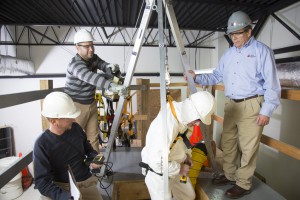On May 4, 2015, the Occupational Safety and Health Administration (OSHA) published  a final rule and new standard for construction work in confined spaces. 29 CFR 1926.1200 Subpart AA (Confined Spaces in Construction) is now aligned with those protections found in the General Industry standard. All construction employers, whose workers may be exposed to confined space hazards, are affected by the rule. Additionally, all employers must have a written confined space program if workers will enter permit spaces. The rule goes into effect August 5, 2015.
a final rule and new standard for construction work in confined spaces. 29 CFR 1926.1200 Subpart AA (Confined Spaces in Construction) is now aligned with those protections found in the General Industry standard. All construction employers, whose workers may be exposed to confined space hazards, are affected by the rule. Additionally, all employers must have a written confined space program if workers will enter permit spaces. The rule goes into effect August 5, 2015.
The U.S. Secretary of Labor, Thomas E. Perez, indicated in a statement that “[the rule] will prevent about 780 serious injuries every year”.
There are 5 key differences to the Construction Confined Space regulation:
- More detailed provisions requiring coordinated activities when there are multiple employers at the worksite. This will ensure hazards are not introduced into a confined space by workers performing tasks outside of the space.
- Requiring a competent person to evaluate the work site and identify confined spaces, including permit spaces.
- Requiring continuous atmospheric monitoring whenever possible.
- Requiring continuous monitoring of engulfment hazards (e.g. when workers are performing work in a storm sewer).
- Allowing for the suspension of a permit, instead of cancellation, in the event of changes from the entry conditions list on the permit or an unexpected event requiring evacuation of the space. The space must be returned to the entry conditions listed on the permit before re-entry.
OSHA has also added provisions to the Confined Spaces in Construction rule that clarify existing requirements in the General Industry Standard, including:
- Requiring that employers who direct workers to enter a space without using a complete permit system, prevent workers’ exposure to physical hazards through elimination of the hazard or isolation methods such as lockout/tagout.
- Requiring that employers who are relying on local emergency services for emergency services arrange for the responders to give the employer advanced notice if they will be unable to respond for a period of time.
- Requiring employers to provide training in a language and vocabulary that the worker understands.
OSHA will also treat compliance with this new rule as compliance with the general industry confined spaces rule when one or more employers are engaged in both general industry work and construction work at the same time in the same space.
OSHA can assess a maximum penalty of $7,000 for each serious violation/failure to comply with the new rule and $70,000 for a willful or repeated violation.
AMA’s 8-Hour OSHA Confined Space Course is compliant with Confined Spaces in Construction AND General Industry Confined Space.


